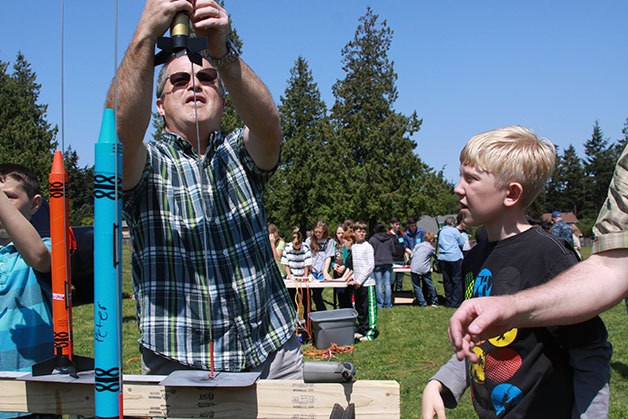If it were up to Gordon Keyes, he’d bring the heavy arsenal to every model rocket launching.
He’s preparing for a trip to Eastern Washington where students in Connell will launch rockets that can reach 1,000 feet into the air from a wide open space.
But in Oak Harbor, Keyes uses a tamer version that travels about half that distance, which works well considering the special factors he must consider.
“The Navy base doesn’t like the larger rockets here,” Keyes said, “because they look like missiles on the radar.”
Keyes has operated his own dental practice in Oak Harbor for 19 years, but he’s tinkered with rockets dating back to childhood and while raising eight children of his own.
“I love launching rockets,” Keyes said. “I have no training whatsoever in rockets other than I have done them a lot with my own children. I am a chemical engineer from the University of Washington and do understand what is happening, though.”
Inspiring children by sharing that knowledge of science through rockets is what fuels Keyes outside of his dental office.
Last year, he started teaming up with Oak Harbor schools to offer an education in rocket science.
In short, he donated model rocket kits to the schools, had the children build them and then returned to supervise during launch day.
Students at Coupeville High School and Broad View and Hillcrest elementary schools in Oak Harbor have participated in the program this spring.
“My motivation is to see the kids’ excitement as their rocket goes up in the air,” Keyes said. “In a world where we are trying to win the hearts and minds of young people to do other things than video games, this points them to science.
“If we get them outside wondering how high their rocket will go versus what level they will win in a video game, I think we succeeded in helping them be excited about science.”
More than 100 fifth-graders from Broad View participated in the program, inspired by a conversation in the dental chair between Keyes and fifth-grade teacher James Schlegel.
“There was no big curricular tie-in here, just a model rocket enthusiast wanting to share a fun, exciting hobby with the kids,” Schlegel said. “However, coincidentally, we have been studying systems and forces of flight in science. So this kind gesture actually became a wonderful culminating activity for our science students. What better way to learn about systems and forces of flight than building a rocket and thrusting it into the sky?”
Parents and sailors from Whidbey Island Naval Air Station volunteered to help the students assemble, launch and retrieve the rockets.
At nearly 2 feet in length and resembling large crayons in a variety of colors, the rockets weigh only a few ounces. They were assembled using wood glue and plastic cement with a twist-on fin unit and nose cone.
Inserted in the cone is an engine filled with gunpowder and a parachute.
At Broad View, students took turns launching rockets, with roughly 12 blasting off at a time following a countdown and the pressing of a button.
The launches took place in the school yard at the rear of the grounds with a few rockets drifting and landing in the vicinity of the front parking lot.
“I think they drifted to Home Depot,” Keyes joked. “No, not really. Depending on the wind, they can drift forever. We lost a few of them.”
Nearly the entire student body at Broad View came outside to view the launches, with most roaring in approval.
“I was overwhelmed by the tremendous support from our community volunteers for the event and the generous donation that made it all possible,” said Lance Gibbon, superintendent of Oak Harbor Public Schools.
“The energy and the joy from the students was contagious. This is a day they will remember for a long time. I’m so grateful that our fifth-graders had the wonderful opportunity to experience building their own rockets and the thrill of the launch.”



